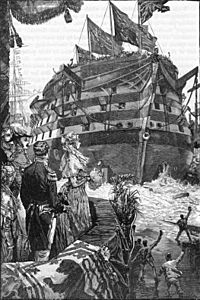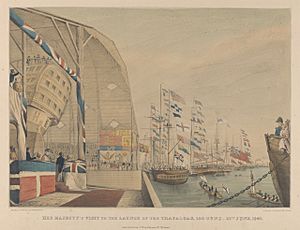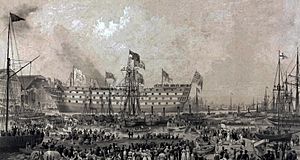HMS Trafalgar (1841) facts for kids

HMS Trafalgar, launched by Lady Bridport, niece of Lord Nelson, accompanied by Queen Victoria
|
|
Quick facts for kids History |
|
|---|---|
| Name | Trafalgar |
| Ordered | 19 February 1825 |
| Builder | Woolwich Dockyard |
| Laid down | November 1829 |
| Launched | 21 June 1841 |
| Renamed | HMS Boscawen, 1873 |
| Fate | Sold, 1906 |
| General characteristics | |
| Class and type | Broadened Caledonia-class ship of the line |
| Tons burthen | 2694 bm |
| Length | 205 ft 5.5 in (62.624 m) (gundeck) |
| Beam | 54 ft 6 in (16.61 m) |
| Depth of hold | 23 ft 2 in (7.06 m) |
| Propulsion | Sails |
| Sail plan | Full-rigged ship |
| Complement | 900 (820 peacetime) |
| Armament |
|
HMS Trafalgar was a very large warship, known as a 120-gun first-rate ship of the line, built for the Royal Navy. It was launched on June 21, 1841, at Woolwich Dockyard in England. This impressive vessel was the last ship to be completed in the successful Caledonia class design.
Contents
Building and Launching a Mighty Ship
The Grand Launch of HMS Trafalgar
HMS Trafalgar was a huge ship, ordered way back in 1825. It took many years to build, finally being laid down in November 1829. The ship was officially launched on June 21, 1841.
A Special Name and Figurehead
The ship was named Trafalgar to honor the famous Battle of Trafalgar. Its figurehead, which is a carved figure at the front of a ship, was a bust of Lord Nelson. He was the British admiral who led the Royal Navy to victory at the Battle of Trafalgar. This figurehead can now be seen at Portsmouth Historic Dockyard.
Royalty and Nelson's Family at the Launch
The ship was named by Lady Bridport, who was Lord Nelson's niece. Queen Victoria herself asked for the ship to be named Trafalgar. The Queen and Prince Albert even attended the launch! It was a very important event.
A Massive Spectacle
During the launch, special wine from HMS Victory was used. This wine had been kept since the Battle of Trafalgar. About 500 people were on board the ship as it launched, and 100 of them had actually fought in the Battle of Trafalgar! It's estimated that half a million people came to watch this amazing event. The River Thames was filled with all kinds of boats, showing how popular the launch was. A local artist named William Ranwell even painted the scene.
Service and Later Life
Fighting in the Crimean War
HMS Trafalgar saw action during the Crimean War. On October 17, 1854, it took part in the Bombardment of Sebastopol. This was a major attack on the city of Sevastopol.
Modern Upgrades and New Roles
In 1859, the ship was updated with new technology. It was fitted with a screw propulsion system. This meant it could move using a propeller, not just sails. This was a big step forward for naval ships.
Later, in 1873, Trafalgar was given a new role. It became a training ship at Portland and was renamed HMS Boscawen. This meant it was used to train new sailors. Commander Lawrence de Wahl Satow was put in charge of the ship on April 15, 1902.
End of Service
HMS Boscawen (formerly Trafalgar) served for many more years as a training vessel. Finally, in 1906, the ship was sold and taken out of service.



